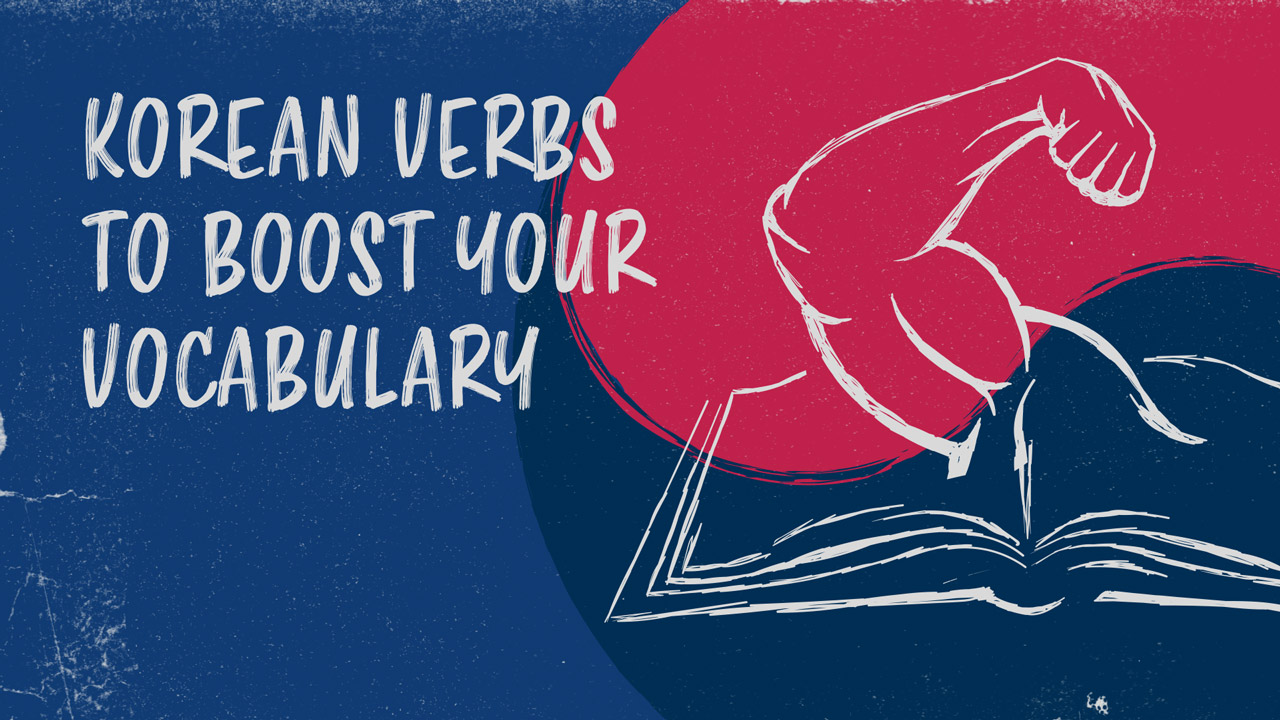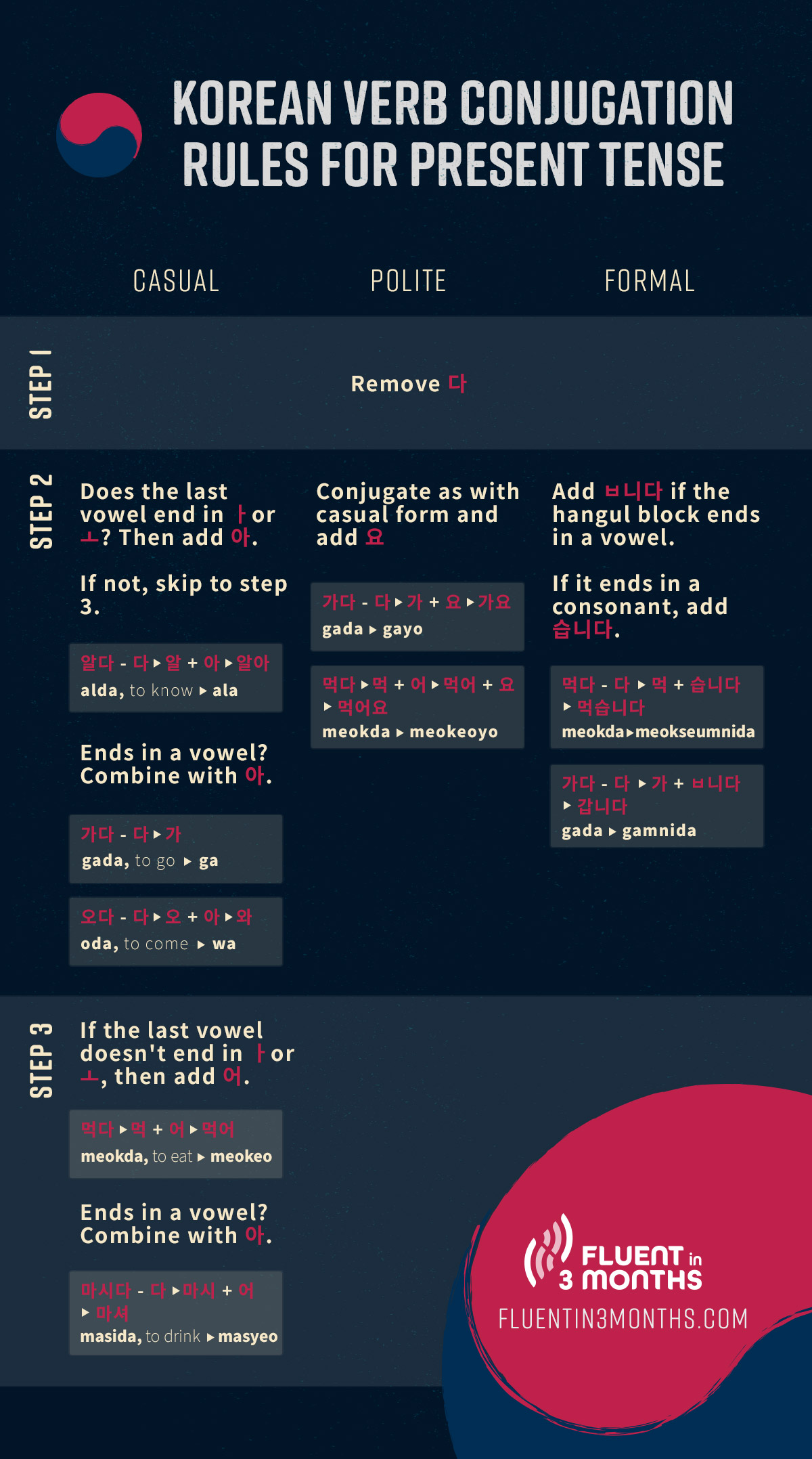101 Must-Know Korean Verbs to Boost Your Vocabulary
No matter what language you’re learning, you have to master your verbs to express what you’re doing. Korean verbs are no different.
But you may be surprised at how different Korean verbs are from English or Romance languages!
Why? Because of Korean culture and sentence structure.
For example, Korean verbs don’t have genders, and you don’t conjugate the verbs to match the subject. Instead, Korean conjugation depends on who you’re talking to and how much respect you need to show that person.
But more on that in a bit.
Table of contents
- 101 Verbs In Korean to Boost Your Vocabulary
- 14 Verbs Using Your Senses
- 22 Essential Actions
- 22 Movement Verbs
- 10 Verbs for When You’re Hungry
- 5 Verbs for Getting Dressed
- 20 Verbs to Express Feelings
- 8 Verbs for When You’re Shopping
- Using Your Verbs: Korean Sentence Order
- Korean Verb Conjugation: The Basics
- Casual Verb Conjugation
- Polite Verb Conjugation
- Formal Verb Conjugation
- Your Korean Skills Have Leveled Up!
(By the way, if you haven’t yet, check out the 101 core Korean words you need to know to understand about 50% of Korean.)
101 Verbs In Korean to Boost Your Vocabulary
Our main focus today is first learning Korean verbs to boost our vocabulary. Because if we don’t know any Korean verbs, we can’t express much, right?
For ease of studying, I like to categorize similar words together so it’s easier to memorize. So that’s what I’ve done here.
Below is a list of 101 common Korean verbs you’ll use every day, broken up into 7 categories based on daily activity.
14 Verbs Using Your Senses
- To see/watch: 보다 (boda)
- To talk/speak: 말하다 (mal hada)
- To ask: 묻다 (mudda)
- To answer: 대답하다 (daedab hada)
- To think: 생각하다 (saenggak hada)
- To sleep: 자다 (jada)
- To dream: 꿈꾸다 (kkumkkuda)
- To make/create: 만들다 (mandeulda)
- To listen/hear: 듣다 (deudda)
- To play: 놀다 (nolda)
- To need: 필요하다 (pilyo hada)
- To be: 이다 (ida)
- To become: 되다 (doeda)
- To be able to do: 할 수 있다 (hal su itda)
22 Essential Actions
- To do: 하다 (hada)
- To learn: 배우다 (baeuda)
- To study: 공부하다 (gongbu hada)
- To write: 쓰다 (sseuda)
- To read: 읽다 (ilkda)
- To work: 일하다 (ilhada)
- To teach: 가르치다 (galeuchida)
- To give: 주다 (juda)
- To receive: 받다 (badda)
- To clean: 청소하다 (cheongso hada)
- To wash: 씻다 (sshitda)
- To call (on the phone): 전화하다 (jeonhwa hada)
- To have: 있다 (itda)
- To not have: 없다 (eopda)
- To finish: 끝나다 (kkeutnada)
- To know: 알다 (alda)
- To not know: 모르다 (moleuda)
- To practice: 연습하다 (yeonseub hada)
- To take (a photo): 찍다 (jjikda)
- To take (to carry): 가져가다 (gajyeogada)
- To draw/paint: 그리다 (geulida)
- To put: 놓다 (nohda)
22 Movement Verbs
- To come: 오다 (oda)
- To go: 가다 (gada)
- To walk: 걷다 (geodda)
- To sit: 앉다 (anjda)
- To wake up: 일어나다 (ireonada)
- To dance: 춤추다 (chumchuda)
- To meet: 만나다 (mannada)
- To exercise: 운동하다 (undong hada)
- To drive: 운전하다 (unjeon hada)
- To ride: 타다 (tada)
- To open: 열다 (yeolda)
- To close: 닫다 (dadda)
- To arrive: 도착하다 (dochak hada)
- To depart: 출발하다 (chulbal hada)
- To enter: 들어오다 (deuleooda)
- To exit: 나가다 (nagada)
- To wait: 기다리다 (gidarida)
- To stop: 그만하다 (geuman hada)
- To hurry: 서두르다 (seodureuda)
- To move: 움직이다 (umjigida)
- To return: 돌아오다 (doraoda)
- To travel: 여행하다 (yeohaeng hada)
10 Verbs for When You’re Hungry
- To eat: 먹다 (meokda)
- To drink: 마시다 (masida)
- To cook: 요리하다 (yori hada)
- To chop: 썰다 (sseolda)
- To boil: 끓이다 (kkeulida)
- To fry: 볶다 (bokkda)
- To stir: 휘젓다 (hwijeotda)
- To grill/bake/roast: 굽다 (gubda)
- To mix: 섞다 (seokkda)
- To pour: 붓다 (butda)
5 Verbs for Getting Dressed
- To wear (a hat or glasses): 쓰다 (sseuda)
- To wear (shirt, pants, dress): 입다 (ipda)
- To wear (shoes or socks): 신다 (sinda)
- To undress: 벗다 (beotda)
- To change clothes: 갈아입다 (garaipda)
20 Verbs to Express Feelings
- To cry: 울다 (ulda)
- To like: 좋아하다 (joha hada)
- To dislike: 싫어하다 (sireo hada)
- To laugh: 웃다 (utda)
- To be happy: 기뻐하다 (gippeo hada)
- To love: 사랑하다 (sarang hada)
- To fall in love: 사랑에 빠지다 (sarang-e ppajida)
- To promise: 약속하다 (yaksok hada)
- To confess: 고백하다 (gobaek hada)
- To worry: 걱정하다 (geokjeong hada)
- To marry: 결혼하다 (gyeolhon hada)
- To lie: 거짓말하다 (geojitmal hada)
- To live: 살다 (salda)
- To die: 죽다 (jukda)
- To fight/argue: 싸우다 (ssauda)
- To win: 이기다 (igida)
- To lose: 지다 (jida)
- To be sorry: 죄송하다 (joesong hada)
- To remember: 기억하다 (gieok hada)
- To decide: 결정하다 (gyeoljeong hada)
8 Verbs for When You’re Shopping
- To buy: 사다 (sada)
- To sell: 팔다 (palda)
- To order: 주문하다 (jumun hada)
- To help: 도와주다 (dowajuda)
- To pay: 내다 (naeda)
- To send: 보내다 (bonaeda)
- To borrow: 빌리다 (bollida)
- To use: 사용하다 (sayong hada)
Using Your Verbs: Korean Sentence Order
If you’re new to Korean grammar, then the first thing you need to know is Korean sentence structure is different from that of English or romance languages.
In English, we use a subject-verb-object sentence structure, or SVO.
I go there. → Subject-verb-object
But in Korean, the order is subject-object-verb, or SOV.
나는 거기에 가다. (na-neun geogi-e gada.) → “I there go.” → Subject-object-verb
While other parts of the sentence can move around a bit, the verb will always come at the end of the sentence in Korean.
Korean Verb Endings
As I mentioned at the beginning, in Korean, you don’t need to conjugate the verb to match the subject. There are no genders, and Korean verb endings don’t change based on the subject.
But Korean verbs do change based on who you’re talking to.
Korean society is very hierarchical, which means you’re expected to show an appropriate amount of respect to others. One way Koreans do that is through verb endings.
In Korean, there are three main speech patterns. Let’s look at them with the verb 가다 (gada, “to go”).
- Casual verb endings: 가다 → 가 (ga)
- Polite verb endings: 가다 → 가요 (gayo)
- Formal verb endings: 가다 → 갑니다 (gamnida)
You’ll most often use polite verb endings the most, as it’s most acceptable in any situation. Casual form is used with peers the same age as you or younger. Formal speech is for elders, bosses, and those with higher authority.
Korean Verb Conjugation: The Basics
There’s a lot to Korean conjugation because there are so many verb endings in Korean. But today, I’ll show you how to conjugate into Korean present tense.
That way, you can take the verbs from the list above, which are in dictionary (or infinite) form, and change them to the level of speech you need.
Casual Verb Conjugation
Learning this one first will help with polite form, so we’ll start here.
First, you may have noticed that all the verbs end in 다 (da). You’ll always need to drop 다 first. Then, if the last vowel remaining is ㅏor ㅗ, you’ll add 아 (a). If it’s anything else, you’ll add 어 (eo).
The one exception is 하 (ha). In this case, it becomes 해 (hae).
Let’s use 먹다 (meokda, “to eat”) as our first example. First, we drop 다.
먹다 → 먹
Now, we need to see what vowel is in the Hangul block. In this case, it’s ㅓ (eo). So we add 어.
먹다 → 먹 + 어 → 먹어 (meokeo)
Now let’s try 가다 (kada). It ends in ㅏ once you drop 다. In this case, it just becomes 가 because the Hangul block already ends in ㅏ.
가다 – 다 → 가
Any time the verb ends in a vowel after dropping 다, 아 or 어 combine with the vowel. If the vowel is the same, you just drop the 다 as we did with 가다.
So another example:
오다 (oda, “to come”)
오다 – 다 → 오 + 아 → 와 (wa)
The 오 + 아 combine in the same Hangul block to create 와 (wa).
Polite Verb Conjugation
Once you know the casual form, the polite form is easy. You simply add -요 to the end.
So let’s look at the examples we just did.
먹다 – 다 → 먹 + 어 → 먹어 + 요 → 먹어요 (meokeoyo, polite “eat”)
가다 – 다 → 가 + 요 → 가요 (gayo, polite “go”)
오다 – 다 → 오 + 아 → 와 + 요 → 와요 (wayo, polite “come”)
Another example is 하다. As I mentioned, it changes to 해 (because the ㅏ combines with 여 to become ㅐ like we saw with 오다 to 와). This is a common verb, so just remember when you add 요, it becomes 해요 (haeyo) in polite form.
Formal Verb Conjugation
To make a formal verb ending, we drop 다 and add ㅂ니다 (-mnida) if the hangul block ends in a vowel. If it ends in a consonant, we add 습니다 (-seumnida).
먹다 – 다 → 먹 ends in a consonant so add 습니다 → 먹습니다 (meokseumnida)
가다 – 다 → 가 ends in a vowel so add ㅂ니다 → 갑니다 (gamnida)
In the case of 오다, we don’t change it to 와 first. We leave it as is, then add ㅂ니다
오다 – 다 → 오 + ㅂ니다 → 옵니다 (omnida)
하다, too, becomes 합니다 (hamnida).
Here’s a Korean verb conjugation chart to help you remember the rules:
Now, there are Korean irregular verbs, too. And those, of course, would have their own set of Korean irregular verb conjugation rules. If you want to check out a list of irregular verbs, this is a good one.
Plus, if you want to see other ways to conjugate Korean verbs or check your notes, Dongsa Korean Verb Conjugator app is super useful. That way, you can try out Korean past tense verbs and future tense and whatever else you like.
But for now, I recommend mastering present tense in these three forms. Play around with the verb list above and check your conjugation skills with the verb conjugator app.
Your Korean Skills Have Leveled Up!
Now that you’ve learned all these helpful Korean verbs and learned the basics of conjugation, you’re ready to put it to use!
Why not learn some practical Korean phrases to use them with? Or have some fun and learn the colors of the rainbow!




Social